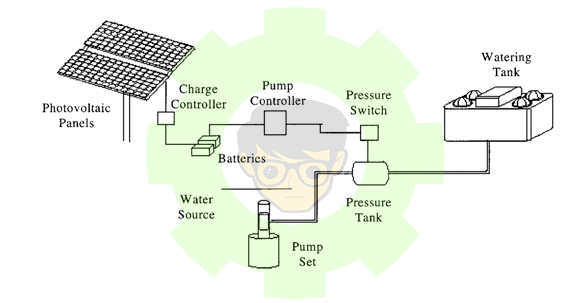
Continued from: Solar Energy for Irrigation: Case of Sri Lanka
Several studies have been done regarding solar irrigation systems, but most of them are regarding DC motor pump systems and drip irrigation systems. Those researches state that the existing systems have to be further developed to get maximum efficiency of the solar energy.
Here are some abstracted information regarding the studies which have done previously.
Abu-Aligah (2011) reported that in locations where electricity is not available, photovoltaic pumping system is a good option for irrigating crops and supplying drinking water. Namibia Renewable Energy Program (NAMREP) conducted a study on feasibility of solar pump in Namibia. This report furnished that for small to medium sized wells, solar photovoltaic pump was much cheaper on a life cycle cost basis than diesel-powered pumps. When looking beyond the original purchase price, solar pumping systems cost from 22-56% higher of diesel pumps cost and can achieve a payback over diesel engine operated pump little as 2 years.
 Table 01: Comparison of features of the existing methods and solar system
Table 01: Comparison of features of the existing methods and solar system
Hahn (2000) has reported that in regions with high insolation levels, photovoltaic pumping systems were technically suitable for use, beneficial for the environment and were able to yield cost advantages over diesel engine driven pumps.
Burkec et al (2010) conducted a study in rural Sudano–Sahel region of West Africa. They reported that solar-powered drip irrigation significantly augmented both household income and nutritional intake, particularly during the dry season, and was cost effective compared to alternative technologies.
Bhat S.R. et al (1987) mentioned induction motors due to inherent advantages are preferred over dc motors for water pumping applications.
A number of experimental pumping schemes, which are driven by DC motors, exist. It has been observed by Betka A. et al (2013) however, that many of these schemes suffer from maintenance problems owing to the presence of commutator and brushes. Since the use of brushless permanent magnet motors is limited to low power PV systems due to their high cost, a pumping system based an induction motor fed either by a voltage source inverter or current source inverter has been proposed as an attractive alternative where reliability and maintenance can be guaranteed.
Several projects on induction motor based solar powered irrigation systems have been done in researches. But most of the projects covered drip-irrigation. (Karve, Khatri, and Rohit, 2013). The systems with larger induction motors running with photovoltaic system are expensive that could not bear for small scale agriculture industries.
According to the above abstracted points of those researches, DC coupled irrigation system is very much popular since it construction is very simple and easy to operate. But it has maintenance problems and those are not economically feasible when it comes to high efficient or larger water pumps.
Let’s consider a solar irrigation system. There are several topologies that are used widely around the world.
First consider DC pump systems. There are two main topologies for DC coupled irrigation systems.
(01) Battery-coupled water-pumping systems

In this system, solar panels are connected to the water pump via a battery backup. Battery backup is connected solar panel through the charge controller device. A solar charge controller manages the power going into the battery bank from the solar array. It ensures that the deep cycle batteries are not overcharged during the day, and that the power doesn’t run backwards to the solar panels overnight and drain the batteries. This topology is capable of supplying water irrespectively the sun light.
(02) Direct-coupled water-pumping systems

In this method solar panels connected directly to the motor via a solar charge controller. This system is designed to pump during only the day time.
As a whole, these DC irrigation systems have some drawbacks. Those are,
- Impeller cannot be direct coupled.
- Current is high compared to AC.
- Torque is low due to low RPM.
- Heat loss is high.
- Life time is low.
- Initial cost is high.
When it comes to the induction motor coupled solar irrigation systems, their construction can be illustrated as follow.

These type irrigation systems are very much popular in large scale irrigation since these systems can handle large amount of water at high efficiency. These systems can be categorized according to the technology used to operate the inverter. As well as these systems are expensive since to operate the induction motor it need array of solar panels rather a single panel. In DC motor system it can operate even by a single panel. But life time of these induction coupled systems are higher than DC motor coupled systems and maintenance are less.
There for need further developments to apply solar powered system in to small scale irrigation, since those existing systems are expensive, inefficient.
References
- Abu-Aligah M. (2011): Design of photovoltaic water pumping system and compare it with diesel-powered Jordan Journal of Mechanical and Industrial Engineering, vol 5, pp. 273-280.
- Betka A., Moussi A. (2013): Optimized solar water pumping system based on an induction motor driving a centrifugal pump. Electrical Engineering Institute, University of Oum El Bouaghi, Algeria.
- Bhat S.R., Pittet A., Sonde B.S. (1987): Performance Optimization of Induction Motor-Pump System Using Photovoltaic Energy Source. Institute of Electrical and Electronics Engineers Transactions on Industrial Applications. pp. 995-1000.
- Burkec M., Burney J., Naylora R., Pasternakb D., Woltering L. (2010): Solar-powered drip irrigation enhances food security in the Sudano–Sahel, Sustainability Science. pp. 1848-1853.
- Hahn (2000): Resource-conserving irrigation with photovoltaic pumping systems.16th European Photovoltaic Solar Energy Conference, Glasgow, UK.
- Karve, Prof. G.M., Khatri and Rohit, K.B. (2013): Solar Water Pumping System. Available at: (Accessed: August 2016).




